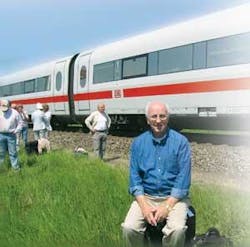You may ask, “What is he doing sitting beside the railroad tracks looking so glum?” You may also be thinking, “Here he goes again with another travel story.” Or you may be intrigued enough to read on.
Lately I have been hearing from my German friends about the decline of the famed Deutsch Bahn–late or delayed trains, poor service, shoddy equipment, and so on. Until now I haven’t had these experiences. But I got it spades on this trip.
I’m traveling from Cologne to Stuttgart on the ICE (high speed) train to connect to a flight to Zurich out of Stuttgart airport. For this, I have allowed an extra three hours. Don’t ask why I fly from Stuttgart; it’s a little complicated.
The train leaves Mannheim and 10 minutes later stops dead in the middle of nowhere. After aborted attempts to restart, we are informed that this train “will not reach its destination.” I learn this from solicitous fellow passengers because I don’t speak German. A “rescue” train is to come to take all passengers aboard.
We are told to take our luggage and exit the train from the front. I am in the next to the last car, and we proceed to walk through eight cars to a platform where an emergency ladder is our means of exit. The train’s platform is five feet above the rail bed. Then we walk, with luggage, through a field to the rescue train parked about 150 feet away, which will be loaded via another emergency ladder into one car. A look at my watch shows that I have lost about 90 minutes from my time cushion, but with a little luck I can still make my plane at Stuttgart airport. However, by the time my fellow passengers and I arrive at the rescue train we are told it is full and another train will come to pick us up.
Forty minutes later another train appears and, with about 30 minutes to get to Stuttgart, it is impossible for me to make my plane, which means I miss my connection in Zurich to Boston. This, in turn, means that I must spend a night in Stuttgart, courtesy of Deutsch Bahn, but I incur a $200 ticket change fee from the airline. So now you know why the disgruntled look.
This brings me to my theme this month; rumor has it that Deutsch Bahn will be privatized. We all know what that portends; an investment team buys the company for an indecent amount of leveraged money promising to effect savings through efficiencies (read this as employee downsizing) and promising the seller (the German government) that service will improve. A few short months later, after all the cash is siphoned off, service experiences better use of equipment (read this as small communities lose service), and in general conditions degrade, unions are unhappy, and the populace suffers.
We have seen it before–look at the British rail system now owned by Americans and Australians. We are about to see it at Chrysler, that dowager among auto makers, who couldn’t make it with Daimler and now looks to be an “also ran” in quality, technology, and sales as pennies are pinched to maximize profits or minimize losses. On this I hope I am really wrong.
An acquaintance makes a living buying distressed companies for no cash and reorganizing them into bankruptcy while he sits on the beach in Nantucket reading the Wall Street Journal’s stories on similar actions.
What a shame that with all the great things the United Sates has to export we should export this shoddy practice.
About the Author

David Belforte
Contributing Editor
David Belforte (1932-2023) was an internationally recognized authority on industrial laser materials processing and had been actively involved in this technology for more than 50 years. His consulting business, Belforte Associates, served clients interested in advanced manufacturing applications. David held degrees in Chemistry and Production Technology from Northeastern University (Boston, MA). As a researcher, he conducted basic studies in material synthesis for high-temperature applications and held increasingly important positions with companies involved with high-technology materials processing. He co-founded a company that introduced several firsts in advanced welding technology and equipment. David's career in lasers started with the commercialization of the first industrial solid-state laser and a compact CO2 laser for sheet-metal cutting. For several years, he led the development of very high power CO2 lasers for welding and surface treating applications. In addition to consulting, David was the Founder and Editor-in-Chief of Industrial Laser Solutions magazine (1986-2022) and contributed to other laser publications, including Laser Focus World. He retired from Laser Focus World in late June 2022.
